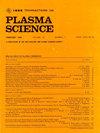地球电离层非热等离子体的单调和振荡冲击
IF 1.5
4区 物理与天体物理
Q3 PHYSICS, FLUIDS & PLASMAS
引用次数: 0
摘要
在磁化等离子体中研究了负离子等离子体中的非线性离子声激波(IASWs、单调声激波和振荡声激波)。假设动态和热离子具有正负极性,而非热电子遵循广义($r,q$)分布。等离子体系统中的耗散是通过离子的运动粘度来承认的。利用约化微扰法(RPM)导出了负离子等离子体的Korteweg-de Vries burgers (KdVBs)方程,并给出了其解析解。得到了负离子等离子体的振荡激波结构,并讨论了其形成的必要条件。为说明密度、负离子温度、正离子温度、方向余弦$l_{z}$、非热电子的谱指数r和q、正离子和负离子的运动粘度的变化对单调和振荡激波结构强度的影响。这些发现可能有助于说明在地球电离层D区和F区观察到的等离子体。本文章由计算机程序翻译,如有差异,请以英文原文为准。
Monotonic and Oscillatory Shocks in Earth’s Ionospheric Nonthermal Plasmas
The nonlinear ion acoustic shock waves (IASWs, monotonic and oscillatory) in negative ion plasmas are explored in magnetized plasmas. Dynamic and warm ions of both polarity (positive and negative) are assumed, while the nonthermal electrons follow generalized ( $r,q$ ) distribution. The dissipation in the plasma system is admitted through the kinematic viscosities of ions. The Korteweg-de Vries burgers (KdVBs) equation is derived for the negative ion plasma using reductive perturbation method (RPM) and its analytical solution is presented. The oscillatory shock structure is obtained, and its necessary conditions for formation are discussed in negative ion plasmas (NIPs). The effects of variations of density, temperature of negative ions, temperature of positive ions, direction cosine $l_{z}$ , spectral indices r and q for the nonthermal electrons, and kinematic viscosities of positive and negative ions on the strength of the monotonic and oscillatory shock structures are drawn for illustration. These findings may be helpful to illustrate the plasmas observed in the D and F regions of Earth’s ionosphere.
求助全文
通过发布文献求助,成功后即可免费获取论文全文。
去求助
来源期刊

IEEE Transactions on Plasma Science
物理-物理:流体与等离子体
CiteScore
3.00
自引率
20.00%
发文量
538
审稿时长
3.8 months
期刊介绍:
The scope covers all aspects of the theory and application of plasma science. It includes the following areas: magnetohydrodynamics; thermionics and plasma diodes; basic plasma phenomena; gaseous electronics; microwave/plasma interaction; electron, ion, and plasma sources; space plasmas; intense electron and ion beams; laser-plasma interactions; plasma diagnostics; plasma chemistry and processing; solid-state plasmas; plasma heating; plasma for controlled fusion research; high energy density plasmas; industrial/commercial applications of plasma physics; plasma waves and instabilities; and high power microwave and submillimeter wave generation.
 求助内容:
求助内容: 应助结果提醒方式:
应助结果提醒方式:


